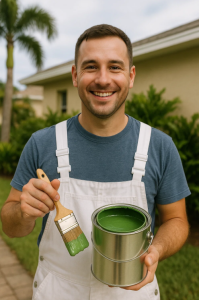Are Eco-Friendly Paints Effective in Florida’s Climate?





 Eco-conscious living is no longer a trend—it’s a lifestyle embraced by homeowners across the country, including those right here in Palm Harbor. If you’re considering a fresh paint job for your home, you may be wondering: Can eco-friendly paint really stand up to Florida’s demanding climate? The answer, as any seasoned Palm Harbor FL Painting Contractor will tell you, depends on the product you choose and how it’s applied.
Eco-conscious living is no longer a trend—it’s a lifestyle embraced by homeowners across the country, including those right here in Palm Harbor. If you’re considering a fresh paint job for your home, you may be wondering: Can eco-friendly paint really stand up to Florida’s demanding climate? The answer, as any seasoned Palm Harbor FL Painting Contractor will tell you, depends on the product you choose and how it’s applied.
Florida’s climate is no joke. With high humidity, heavy rain, salty air, and relentless UV rays, homes here need more than just pretty colors—they need serious protection. In this blog, we’ll explore the world of environmentally friendly paints, how they perform in harsh weather, and how to choose the right product that delivers both eco-consciousness and durability.
What Is Eco-Friendly Paint?
Eco-friendly, or “green,” paint is designed to reduce negative impacts on human health and the environment. These paints typically feature:
- Low or zero VOCs (volatile organic compounds)
- Non-toxic ingredients
- Low odor
- Natural or plant-based additives
- Sustainable manufacturing practices
VOCs are harmful chemicals that evaporate into the air and can cause respiratory issues, headaches, and long-term health concerns. Traditional oil-based paints are notoriously high in VOCs, but many modern water-based latex options now offer low- or zero-VOC formulas without sacrificing quality.
Why Eco-Friendly Paint Matters in Palm Harbor
1. Indoor Air Quality
Many Florida homes use HVAC systems nearly year-round. That means paint fumes have less opportunity to ventilate, potentially recirculating indoors. Low-VOC or no-VOC paints are especially valuable for:
- Families with children
- Individuals with allergies or asthma
- Homes with pets
- Energy-efficient homes with tighter insulation
2. Environmental Responsibility
As part of a coastal community, Palm Harbor residents are increasingly aware of environmental protection. Eco-friendly paints reduce air pollution, limit contamination of water systems, and support broader sustainability goals.
3. Safer Application in Humid Conditions
Because of Florida’s consistent moisture and heat, eco-friendly latex paints are often better suited to the climate. They dry faster, emit fewer fumes, and are easier to clean up with water—making them safer for painters and occupants alike.
Can Eco-Friendly Paints Stand Up to Florida’s Harsh Climate?
This is the big question—and the answer is YES, as long as you use high-quality, weather-rated products designed for extreme environments.
Top Concerns in Florida’s Climate:
Environmental Factor | Challenge to Paint | Eco-Friendly Paint Solution |
Humidity | Causes mildew/mold | Use mildew-resistant formulas with antimicrobial agents |
Salt Air | Corrodes coatings | Choose paints with salt and moisture resistance |
UV Rays | Fades colors | Use paints with built-in UV blockers and reflective pigments |
Rain & Moisture | Causes blistering, peeling | Apply breathable, waterproof latex coatings |
Temperature Swings | Causes cracking | Use flexible acrylic resins in water-based paints |
Modern eco-friendly paints incorporate advanced binders, UV blockers, and mildew resistance to handle these challenges effectively.
Types of Eco-Friendly Paints and Their Benefits
1. Low-VOC and Zero-VOC Latex Paints
These are the most commonly used green paints for residential jobs. Today’s top latex products offer:
- Quick drying (important in Florida’s moist conditions)
- Excellent adhesion to stucco, wood, and concrete
- Long-lasting color retention
- Minimal environmental impact
Brands to Consider:
- Benjamin Moore Natura®
- Sherwin-Williams Harmony® and Emerald®
- Behr Premium Plus® Zero VOC
2. Natural or Plant-Based Paints
Made with ingredients like citrus, clay, or casein, these paints are incredibly low in toxins. However, they are:
- More expensive
- Harder to find
- Less durable in extreme weather
They may work well for interior accent walls or artistic projects, but are generally not recommended for full-home exteriors in Florida.
3. Recycled Paints
Some companies reprocess surplus latex paints to reduce waste. While eco-friendly in principle, quality and consistency vary, making them a better fit for garages, sheds, or low-visibility areas.
How Long Do Eco-Friendly Paints Last in Florida?
When applied correctly, high-quality eco-friendly exterior paints can last 8–12 years—comparable to or even exceeding traditional products.
Key to Longevity:
- Proper prep: Pressure washing, patching, and priming are critical.
- Right timing: Apply during dry weather with moderate temperatures.
- Correct finish: Satin or semi-gloss resists mildew and allows easy cleaning.
- Professional application: A skilled Palm Harbor FL Painting Contractor knows how to get the most out of eco-friendly products.
Eco-Friendly Paint for Interiors in Palm Harbor
Florida’s indoor spaces, especially bathrooms and kitchens, are highly humid environments. You need paint that can stand up to moisture without emitting harsh chemicals.
Best Interior Features to Look For:
- Washability: Choose paints labeled “scrubbable” for high-traffic zones.
- Mildew resistance: Ideal for bathrooms, laundry rooms, and basements.
- Matte to semi-gloss finishes: Offer balance between aesthetics and durability.
Top Picks:
- Benjamin Moore Aura® Bath & Spa
- Sherwin-Williams Harmony® Interior Acrylic
- ECOS Paints (zero VOC, non-toxic)
Pros and Cons of Eco-Friendly Paint in Florida
✅ Pros
- Healthier for your family and pets
- Minimal environmental impact
- Low odor and safer to apply indoors
- Excellent durability when using premium latex
- Suitable for year-round Florida use
❌ Cons
- Slightly higher cost per gallon
- Some products require more coats
- Limited selection of natural paints in retail stores
- Not all eco-paints are mildew-resistant—read the label
How to Know If a Paint Is Truly Eco-Friendly
Don’t just trust marketing language. Look for third-party certifications such as:
- Green Seal®
- GREENGUARD Gold Certification
- EPA Safer Choice
- LEED compliance
- ASTM D-5116 certification for low chemical emissions
Also, consult your Palm Harbor FL Painting Contractor to verify the product is appropriate for Florida’s unique environmental challenges.
How Much More Do Eco-Friendly Paints Cost?
The cost of going green has dropped significantly over the years. You can expect to pay:
- $30–$60 per gallon for premium low-VOC or zero-VOC paints
- Compared to $20–$40 per gallon for traditional latex
But with fewer repaint cycles, better indoor air quality, and easier cleanup, the long-term savings and health benefits outweigh the extra upfront cost.
Tips for a Successful Eco-Friendly Paint Job
- Prep thoroughly—this step is even more important with breathable water-based paints.
- Choose the right finish for your climate zone (semi-gloss for exteriors, satin for interiors).
- Ventilate well during and after painting, even with low-odor products.
- Apply during mild weather—avoid peak summer humidity and rain.
- Hire a professional who is experienced in using eco-friendly products and understands Florida weather patterns.
Final Thoughts: Can Eco-Friendly Paint Handle Florida?
Absolutely—if you choose the right product and partner with the right painter. Today’s eco-friendly paints are highly advanced and designed to perform in the toughest conditions, including Palm Harbor’s salt air, sun exposure, and humidity. With proper preparation and professional application, these paints offer vibrant, lasting color and long-term protection—all without compromising your health or the environment.
To get the most out of your investment, work with a trusted Palm Harbor FL Painting Contractor who uses green-certified paints and applies them with expert care.
Coming Up Next:
Can paint actually shield your home from Florida’s intense rain and sun? Find out in our next post, Can Paint Protect My Home from Florida’s Heavy Rain and Sun?, where we dive into the science behind paint performance and long-term exterior protection.

100% Satisfaction Guarantee

Licensed and Insured

Color Consultation

3 Year Warranty
Services

Our team of experts does popcorn ceiling removal and wallpaper removal. We also do drywall and stucco repairs as well as texturing, soffit and fascia repair.
Painting Service Locations

How long does it take to paint my house?
What is included with your free estimate?
All of our estimates include a fully detailed scope of the work to be completed. You will receive a report with a breakdown of the cost and time estimated for your project.
How do I get my project scheduled?
Simply follow the steps in the estimate to schedule or give us a call, text, or email. Whichever is convenient for you works for us.
Why does a house have to be pressure washed before painting?
If you’re planning to paint the exterior of your home, you may be wondering why pressure washing is such an important step. After all, a little dirt and grime shouldn’t stop the paint from sticking, right? Unfortunately, it’s not that simple. Over time, dirt, mildew, and other pollutants can build up on the surface of your home, causing the paint to chip and peel. Pressure washing removes this build-up, giving the new paint a clean surface to adhere to. In addition, pressure washing also helps to remove any chalky residue left behind by old paint. This ensures that the new paint will have a smooth, even finish. For these reasons, it’s always best to have your home professionally pressure washed before painting
Item How often does a house need to be repainted?
The frequency with which a house exterior needs to be repainted depends on a number of factors, including the type of paint used, the climate, and the level of exposure to sun and rain. In general, however, most experts recommend repainting every three to five years. High-quality paints that are properly applied can last for about 10 years, while lower-quality paints may last less. The climate also plays a role in how often a house needs to be repainted. For example, homes in areas with high humidity levels may need to be repainted more frequently than homes in dry climates. Exposure to sun and rain can also shorten the lifespan of paint, so homes that are exposed to these elements may need to be repainted more often than those that are not. Ultimately, the best way to determine how often a house exterior needs to be repainted is to consult with a painting contractor who can assess the condition of the paint and make a recommendation based on individual circumstances.
Trustindex verifies that the original source of the review is Google. I want to thank Curb Appeal Pros for doing an amazing job of painting the exterior of my house. Sending a big shout out to owner, Jay McGarrity, for being so patient, professional, and fair with the pricing, timing, and color choices. When I changed my mind about the original colors that I had selected, Jay came back to my house twice (including Father's Day) to test some different paint samples I had purchased from Sherwin Williams. The final result was exactly what I wanted and my house looks fabulous! I will hire Curb Appeal Pros again when I am ready to have some interior painting done.Trustindex verifies that the original source of the review is Google. They repaired stucco on the fireplace exterior and outside window sills, pressure washed the house, and my shed in the backyard. Painted the house and all fascia and soffits. They did an outstanding job !! Would not hesitate to use them again.Trustindex verifies that the original source of the review is Google. Amazing job filled in all the settling cracks and made the house look amazing would highly recommend them to anyone who’s looking to fix their home up.Trustindex verifies that the original source of the review is Google. What a great experience. Joey worked with me to get the house painted in between projects so I could have the house painted before my new gutters were put in. I didn't have to be home, which was a plus. The painter Angel and Nathen which I got meet at the end of the project were friendly and professional. I would definitely recommend Curb Appeal. Joyce Walter.Trustindex verifies that the original source of the review is Google. We recently hired Curb Appeal Pros to paint our living room,dining room, family room and kitchen. They were easily up to the task. I had different colors,different paint finish’s, texturing and an accent wall as well. Angel and his crew did an amazing job.They were organized ,pleasant ,and had my entire house finished in less than 3 days. They removed all the large furniture and carefully put it back in its place perfectly after the job was done ! The owner was hands on and was easy to reach and made sure that my questions were answered without delay or hesitation. My house looks amazing . They went the extra mile in every way and we are so grateful . Thank you Curb Appeal for a job well done. I recommend you contact them for all your painting needs.Trustindex verifies that the original source of the review is Google. Curb Appeal Pros is a 'one stop shop'. They recently painted our house and installed ledger stone on the exterior of our house. After the job was completed, we contacted Jay McGarrity about a detail. Jay immediately responded and came back to the house even after payment! The end result of their work is beautiful. Jay and his Team are a pleasure to work with.Trustindex verifies that the original source of the review is Google. reliable, great work, honest pricing. i highly recommend these pplTrustindex verifies that the original source of the review is Google. Fair price and good work. What more can you ask for?Trustindex verifies that the original source of the review is Google. Excellent job. Jay was quick to respond to everything we asked, kept us well informed and made sure the job was done exactly how we asked. Will definitely recommend to everyone who asks, which we have already done several times as of this review. Truly thankful for the professionalism when so many companies now lack it!
Request An Estimate

copyright @2025 all rights reserved | Privacy-policy